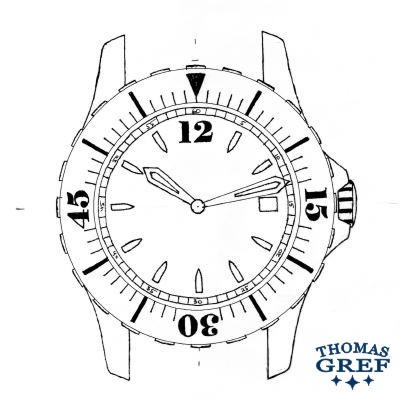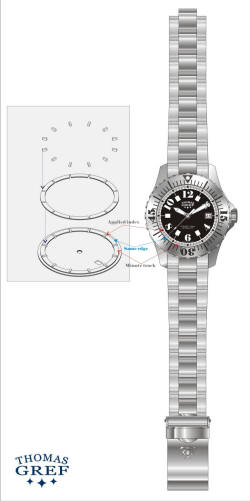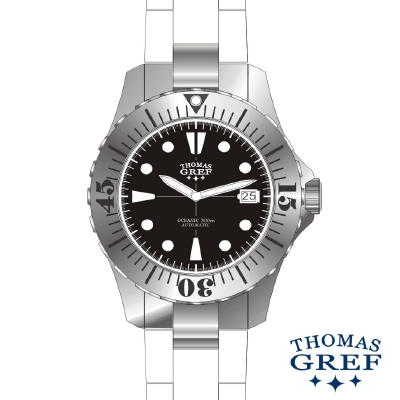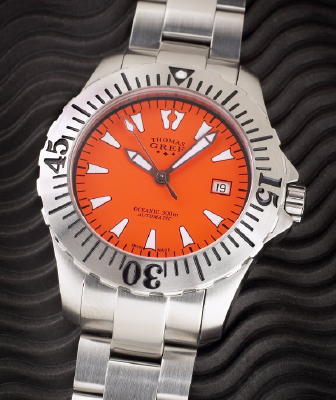|

How to Design and Build a
Custom Watch
|
One of my customers
once told me this saying: 'the job of the amateur is to
underestimate the job of the professional' - which seems to apply
universally. Since there is quite a bit of interest in exactly
how a watch is designed and built, I decided to reveal some of the
steps in creating my dive watch, the Oceanic. I get quite a
few inquiries from people who want to make just one custom-made
watch, without realizing how much time and effort is required to get
the job done. It is much more expensive, time-consuming, and
detail-oriented than most people think. It certainly isn't
feasible to make just one watch - most manufacturers have a minimum
quantity order of at least 300 pieces (applies to cases, dials,
hands, and all other components). This watch took over a
year to produce, from the initial drawings to the finished product.
Obviously, at first
you have to decide roughly what the watch will look like and its
basic characteristics. I started out with simple drawings on
graph paper. I knew I wanted to do a dive watch with a
rotating bezel. I wanted to have something very robust, and
from the beginning I knew I wanted a solid steel bezel which
had the look and quality of a fine etched stainless steel
machinist's ruler. This design is pretty indestructible, and
is superior to the anodized aluminum bezel inserts that many other
manufacturers use which are prone to fading.
Here are two of
my initial drawings. One drawing shows some initial efforts to
sort out the details of the notches on the bezel. |
 |
 |
|
Once I got the
drawings done roughly to scale, I moved on to making 2-dimensional
drawings/renderings on the computer. This is where many of the
details are worked out. I tend to generate many different
designs, then choose the best. I will then refine what I think
are the best one or two designs to come up with a 'finished' 2-D
rendering. The design on the left is essentially the finished
watch (this is a thumbnail). Even this 'simple' 2-D drawing is
made up of approximately 3,000 separate objects, all located within
.01mm! The design on the right is one that I decided not to
use. I generated about 8 different dial designs, and probably
20 or so revisions on these drawings.
At this point it is
necessary to make a firm decision on the movement to be used, as
that will dictate the location and size of the date window for this
drawing. Of course, as the design gets refined, it will
influence the inside dimensions of the case and the specifications
for the dial and hands. |
 |
 |
| Once the 2-D
drawings are in their final stages, the 3-D drawings come next.
These will define the thickness and curvature of the case and its
many components. I spent a lot of time refining the bezel and
the shape and size of the teeth on the bezel, so that it provided
enough grip without catching on clothing. The drawing on the
left shows a cross section of the center of the case, which shows
the dial, crystal, movement ring, etc. As you can see,
everything is specified down to the last detail. |
| Next the
isometric views and 3-D renderings can be done to show the watch in
its near completed form. It is very important to check every
last detail at this stage, before any samples and tooling are made.
|
| Once all of the
drawings are approved, then a sample case is produced. This
sample is generally made from a softer grade of stainless steel
which is easier to prototype, as the 316L steel used in the final
product is fairly difficult to work with. The properties of
hardness and ruggedness of 316L stainless steel that are desirable
in the finished product also make the material somewhat hard to
machine and polish, so it is reserved for the finished product only.
From the first
sample, I chose to make the final watch case thinner to reduce its
weight, but otherwise it was very close to the finished product. |
 |
 |
| Obviously I
have left out a lot of steps, but this should give you a good
overview of the process and complexity of making a watch. I
didn't even touch on producing the dials or hands, and all of the
details in specifying colors and finishes (there are many different
shades of orange, for example, and glossy paint shows color
differently than semi-gloss or matte paint).
Some people also think
that it is possible to put any movement in any case - which is not
true. In a watch, most of the design centers around the
movement. The dial has 2 feet (locating pins) which are
specific to the movement, the hole sizes in the hands are specific
to the movement, the location of the date window is specific to the
movement, and the case is designed for only one movement.
Everything is custom built for one model.
Follow the link
at the top of the page to see the other Oceanic models. |
| This section
is here for educational purposes only.
I no longer provide
any custom watch making services, as I have had way too many
non-serious inquiries that just consume too much time. I don't
respond to any inquiries regarding custom watches, as, in total, it
is not profitable for me to do so.
|

Thomas Gref
- AWI Certified Master Watchmaker - BS Mechanical Engineering
PO Box 69151 -
Tucson, AZ 85737 - USA -
ph
520.818.3382
|